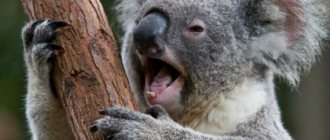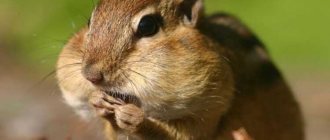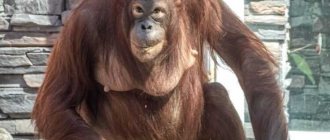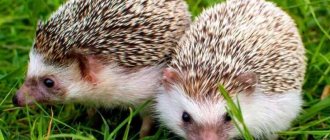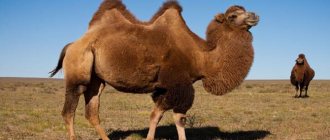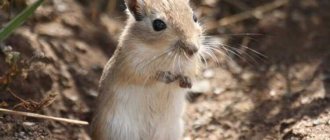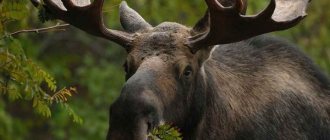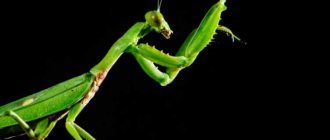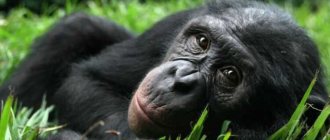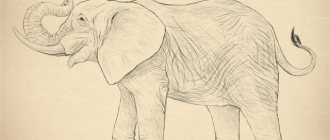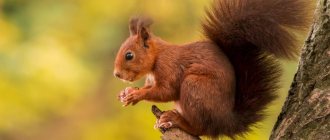Review author: “ZooVita”
These funny animals live in the trees of Australia. The koala is the animal with which this country is primarily associated. With all their cute, toy appearance, they resemble the teddy bears beloved by children.
The photo of the koala animal evokes delight and tenderness. You will learn about the life and habits of these funny creatures belonging to the subspecies of marsupial bears from this article.
Appearance of the animal koala
The animal looks like a bear cub, about seventy centimeters in height. In weight, even large males do not exceed fourteen kilograms, and females do not exceed five kilograms. Animals in the south are larger than their northern relatives.
The photo of the koala shows that the female has a leather pouch on her stomach, in which she carries the cub. Sometimes koalas look completely different in different photos.
The color of a koala is determined by the color of its fur. The mammal has soft, medium-density fur on its back, usually of a smoky gray, reddish or reddish hue.
What color a koala is depends on the specific habitat of the individual. On the belly, the hair is usually of a lighter shade. The fur hairs are about two centimeters long.
The koala has a large head with a flat muzzle, button eyes and mobile, large, splayed oval ears covered with fur. Strong paws with tenacious claws allow these animals to climb trees well.
There are a pair of toes on one side of the paw and three on the other. With the help of this structure of the fingers, the animal can securely fixate on the tree. A distinctive feature of koala finger pads is a unique print, like those of humans or monkeys.
The koala's thirty teeth, some of which are incisors and others are grinding teeth, are so strong and sharp that the mammal is capable of chewing the tough, dense eucalyptus leaves into a pulp.
Pregnancy lasts one month
0
A koala's pregnancy lasts no more than 30-35 days. Only one cub is born - at birth it has a body weight of 5.5 g and a length of only 15-18 mm. Females are born more often than males. It happens that twins appear, but this is rare. The cub remains in the mother’s pouch for six months, feeding on milk, and when this time passes, it “travels” for another six months on her back or stomach, clinging to her fur with its claws.
Origin of the koala species
There is no consensus among scientists about the specific time of appearance of koalas. One group believes that the ancestors of mammals already existed more than five million years ago, while others suggest that animals appeared in Australia only three million years ago.
Due to the lack of family ties in the mammal with other animals, despite some similar features with bears, it is impossible to more accurately determine their ancestors
Etymology
The genus name Phascolarctos comes from the Greek phaskolos, meaning "bag", and arktos, meaning "bear".
Literally translated, Phascolarctos sounds like “marsupial bear.” Because of its fur color, the species was given the name cinereus, which translates as “ashy.”
The koala has nothing in common with the bear family, since it is the only representative of Phascolarctos.
But due to their external similarity with the first ones, they received the name koala bear. Outside Australia, this species name is very common, although it is incorrect.
The marsupial bear is very similar in appearance to the wombat, which also lives in Australia.
The animal differs from its closest relatives in having thicker hair, long limbs and large ears.
Habitat of the koala animal in the wild
These mammals live only in Australia. Their habitat is the coastal regions of the country. Koalas were introduced in the twentieth century. The northernmost zone where these animals live is Magnitny Island.
A large number of these mammals died in southern Australia about a hundred years ago. The number of animals began to increase, importing them from other lands of the country.
Now mammals are located over a fairly large territory. In areas with dense eucalyptus forests, you can find many koalas. They like the high humidity of these forests, desert lands with small copses.
A sufficient amount of food determines the high population of koalas in the area. Therefore, the southern regions, abounding in rain forests, sometimes number eight individuals per 10,000 square meters, while the western territories are able to feed only one individual on land 100 times larger.
History of discovery
"Discovery" may not be the appropriate term in this case, as fossil evidence points to the presence of the koala in Australia since the Miocene, with the species dating back 25 million years to the Riversleigh site in Queensland.
The Aborigines have always known about the existence of the animal. The koala is part of their complex culture, the central character of the Dreamtime. They used the animal for food and fur, and carved images on rocks.
The scientific discovery of this marsupial took place in August-September 1803, and concerned the type specimens collected at Hut Hill (Mount Kembla) in the Illawarra Game Reserve area of New South Wales.
The animals, including living specimens brought to Sydney in August 1803, were depicted by the botanical illustrator Ferdinand Bauer and described by the famous botanist Robert Brown, members of a scientific expedition on His Majesty's survey ship Investigator under the command of Captain Matthew Flinders.
Drawings, descriptions and parts of dead animals were soon sent to England. But the circumstances were such that the information was mostly put aside, not processed and not published.
In reality, the "discovery" of the koala is shrouded in mystery, as New South Wales was a penal colony at the time. Free scientific research was not easy to organize.
In addition, Captain Flinders was arrested and imprisoned in Mauritius, which affected plans to publish a detailed account of the expedition's results.
Thus, the British missed the opportunity that was presented by both a competent scientist and a specialized artist at the time of the discovery of the koala.
The animal was studied between 1814 and 1817 by a group of French and German zoologists who, as far as is known, had not seen living koalas and did not have access to the July–September 1803 type specimens. The prominent role of Ferdinand Bauer and Robert Brown in this discovery has been reduced to a historical footnote.
Between 1798 and 1802 it was believed to be a sloth or a monkey. Although in 1836 settlers in the colony of New South Wales still called it a monkey, and later during the 19th century - the native bear.
The animal was described as lazy, sleepy, ugly and could not compare with more interesting and exotic species for scientists, like the platypus and kangaroo.
The first mention of the koala comes from a message from John Price, a servant of John Hunter, Governor of New South Wales, who traveled as part of John Wilson's expedition to the Blue Mountains in 1798. He wrote in his diary: “There is another animal, which the natives call “Kullavain,” and it looks like the sloth in America.”
The comment suggests that Price actually saw the animal, perhaps resting on the branches of a tree, like a sloth. Price's diary was published a century later in the Historical Records of New South Wales series.
Nutrition of koalas in the wild
The basis of the diet of koalas is young growth of eucalyptus. Few animals still eat such vegetation, so here koalas have practically no competitors, which increases the survival factor.
Only thanks to its strong teeth is the animal able to chew foliage and rough shoots, and the special taste and aromatic properties, not to mention the significant amount of phenolic substances, do not contribute to the large number of lovers of this product.
There is practically no protein in it, and in the fall the shoots accumulate real poison. But it does not threaten koalas, since their nose allows them to find for food those eucalyptus trees where the poison content is too low for poisoning. Similar trees grow near rivers.
Brain
The koala's brain also has features - it's just small. In the world, the koala has the smallest brain region in relation to the body. It will be only 0.2%.
According to scientists, this is only due to adaptation to an exclusively low-calorie diet.
Lifestyle and behavior of koalas
The animal's entire life is spent on eucalyptus. The koala appears on the surface of the earth only to move to a tree where there is more food. During the day they sleep for a long time, sometimes up to twenty hours at a time.
At night, activity increases, especially in terms of eating. It takes about three hours to feed. Suddenly the animal may freeze motionless and sit in this position for several hours in a row.
Despite its inhibition, at the sight of any serious danger, the koala can quickly run in order to then hide at a height, in the crown of a tree. If necessary, the mammal swims across a river or other small body of water.
Despite the naturally quiet voice, at the slightest danger the animal is capable of emitting a very loud cry.
Koalas are characterized by recluse, loneliness and sedentism. Individuals rarely leave their homes. If a relative appears on the territory of an animal, and especially a male during the mating season, then a fight occurs between competitors.
Motionless most of the day
0
For most of the day, Australian koalas are motionless. During the day they sleep for approximately 16 hours, and even if they do not, they prefer to sit still and look around. The main thing is that when they are sleeping, no one shakes the tree or the wind blows; if this happens, the koala will fall from the tree, and the consequences can be sad. By sitting still, the animal conserves its energy in this way - this allows it to digest food, given that this takes a lot of time.
Enemies of the koala animal in the wild
The animal's natural enemy is the wild dog. Dingo rarely attacks, but then medical attention is often necessary. There is a specialized clinic for koalas near Sydney, where they are treated after such attacks and after the animal was hit by a car.
Another enemy of the koala is man, due to the fact that he increases the number of roads in the forests of Australia. Due to their clumsiness and slowness, koalas often die under the wheels of cars.
Koalas often get cystitis, conjunctivitis, sinusitis, and chlamydia. The immunodeficiency virus, the so-called retrovirus, leads to the death of the animal in 80% of cases. It causes lymphoma, malignant tumors and damage to the immune system.
Lifestyle
The koala forages for food after dark. During the day, the animal sits on a tree and chews leaves, which it managed to put behind its cheeks during prey, or sleeps with one paw hooked on a branch.
This species of the marsupial family, like pandas prefers a passive lifestyle. Koalas remain practically motionless for up to 18-20 hours a day, sitting on a tree.
They descend to the ground only in rare cases when they cannot jump to a neighboring tree.
The animal's phlegmatic nature is explained by its diet, which includes plant foods that are poor in protein content.
Marsupials are silent, except during mating periods, when males attract females by screaming. Koalas also use their “voice” in times of danger.
In the wild, the species has no enemies, with the exception of the dingo dog, which can hunt herbivorous animals if it is very hungry. Other predators do not eat koalas due to their high toxicity.
The koala bear prefers a solitary lifestyle, excluding the mating period. At this time, males often attack each other when meeting.
During mating, individuals gather in groups of several females and one male.
How long do koalas live?
In wild, natural conditions, animals can live for about twelve years, and in captivity, twenty-year-old individuals are sometimes found, albeit extremely rarely.
One can note the special friendliness and calm disposition of these cute animals. They are very trusting and harmless creatures. They can be easily tamed, as the koala quickly gets used to humans.
Contemplating the measured, unhurried lifestyle of this unique mammal, you can take your mind off the hustle and bustle, calm your nerves and lift your spirits.
When frightened, they make a sound similar to a child's cry.
0
It is better not to scare the koala again, because this amazing and cute animal makes a sound reminiscent of the cry of a small child... It cannot leave anyone indifferent. A wounded or frightened koala cries, but usually this animal does not make any sounds and prefers to remain silent most of the time. At the age of one year, a koala can begin to lead an independent life, but if its mother leaves it before that, the animal will cry because it is very attached to her.
